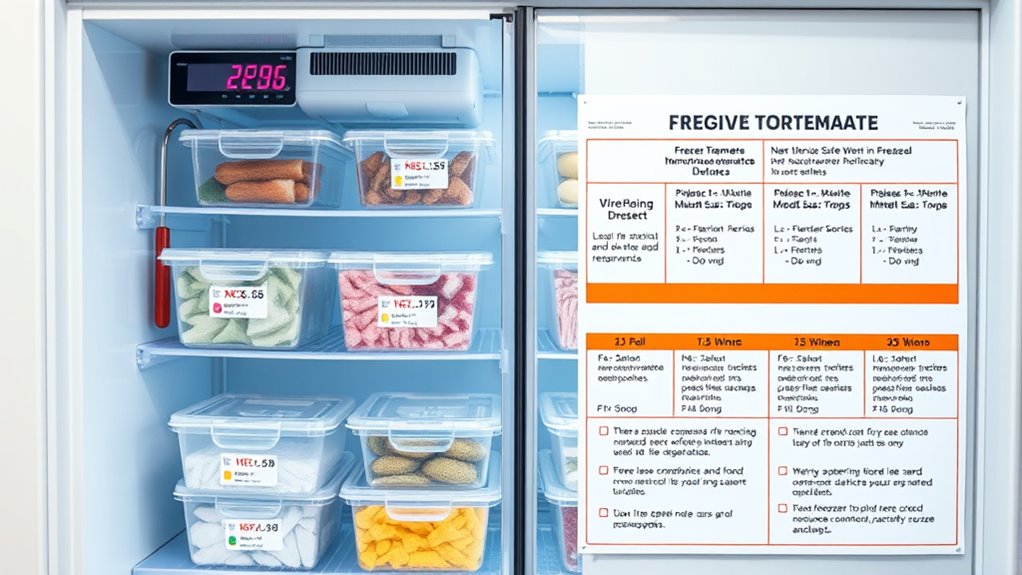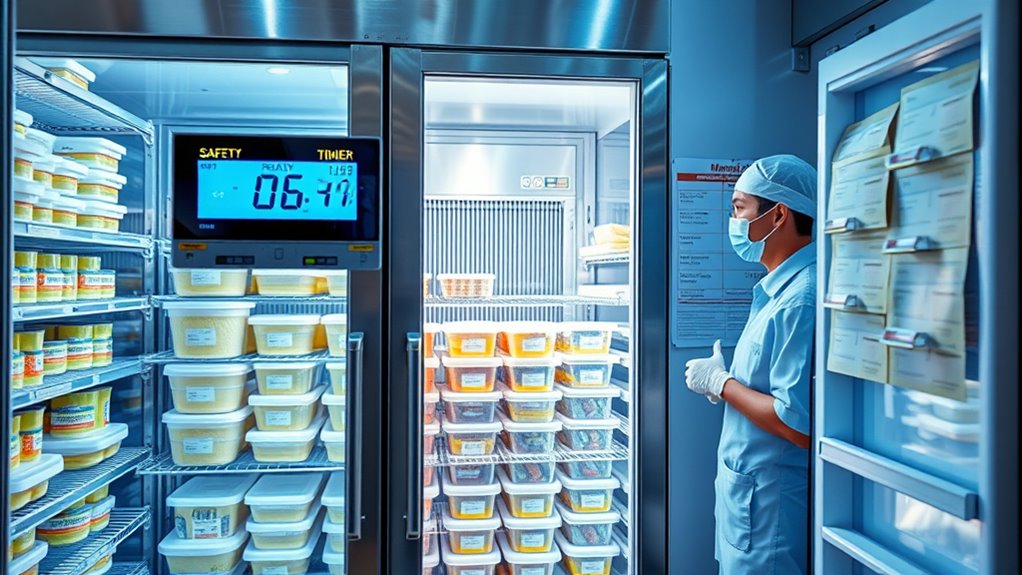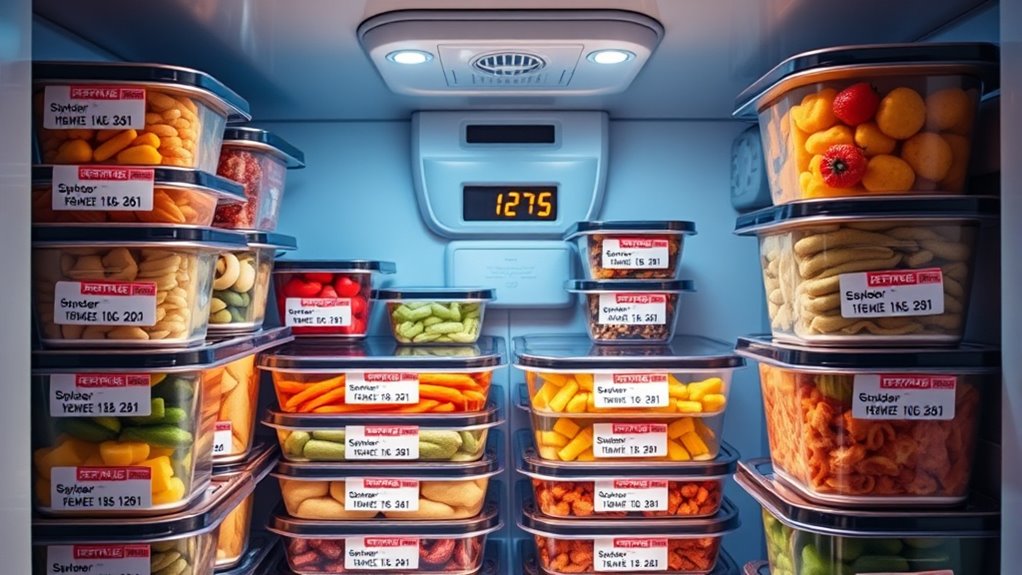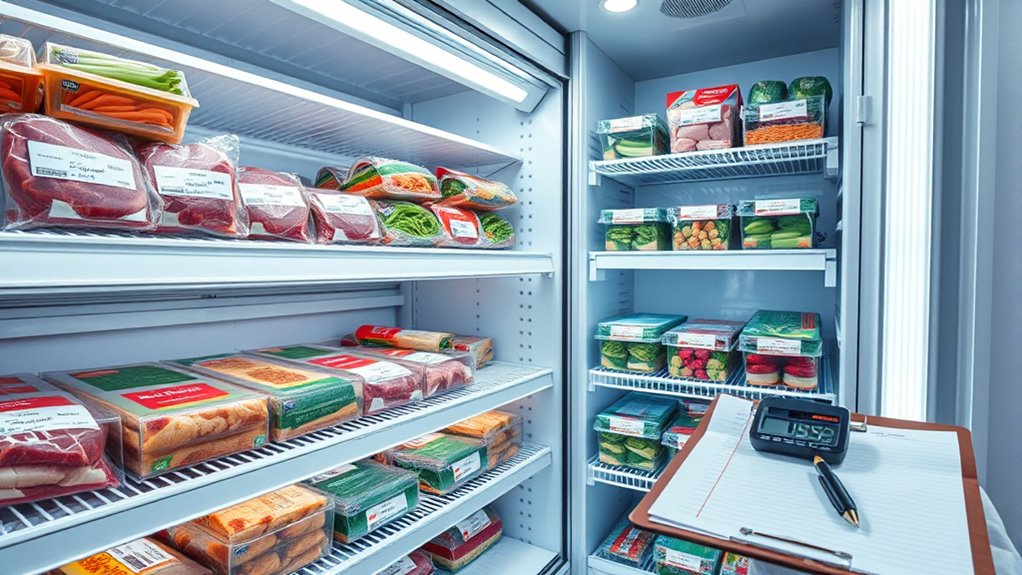To guarantee effective freezer maintenance and food safety, set clear time limits for different items, like 3-6 months for raw meats and 2-3 months for leftovers. Use reliable temperature monitoring tools, label all items with dates, and implement routine inventory checks with first-in, first-out rotation. Regularly review your procedures and update training to prevent spoilage and maintain quality. Keep an eye on these best practices, and you’ll discover more ways to keep your freezer running safely.
Key Takeaways
- Implement and regularly calibrate temperature monitoring tools to ensure consistent 0°F storage conditions.
- Use clear, durable labeling with dates and contents to facilitate effective inventory rotation and FIFO practices.
- Conduct routine freezer audits and inventory checks to identify expired or spoiled items promptly.
- Train staff thoroughly on proper storage, handling, and time window adherence to prevent food safety issues.
- Establish and follow a maintenance schedule for freezer equipment to prevent breakdowns and maintain optimal conditions.
Understanding Critical Freezer Time Windows

Understanding critical freezer time windows is essential to maintaining food safety and quality. When you know how long food can stay safely frozen, you prevent spoilage and avoid freezer burn caused by excessive freezer frost buildup. Overloading your freezer reduces its effective storage capacity, making it harder to maintain consistent temperatures. This can lead to uneven freezing and compromised food safety. To optimize storage, keep the freezer organized so that air circulates freely, helping to reduce frost and maintain ideal conditions. Regularly monitor your freezer’s temperature, keeping it at 0°F (-18°C), and avoid overcrowding, which diminishes capacity and hampers proper freezing. Mastering these time windows ensures your food stays fresh and safe, maximizing your freezer’s efficiency. Additionally, using vacuum sealers can help extend the shelf life of frozen foods by preventing freezer burn and maintaining quality over longer periods.
Setting Clear Guidelines for Food Storage Duration

To keep your freezer organized and guarantee food stays safe, it’s important to establish clear storage duration guidelines. Proper food storage depends on knowing how long items remain safe at ideal temperature control. Set specific time limits for different foods to prevent spoilage and freezer burn. Use the table below as a reference:
| Food Type | Storage Duration | Storage Tips |
|---|---|---|
| Raw meats | 3-6 months | Vacuum seal for freshness |
| Cooked leftovers | 2-3 months | Label with date |
| Fruits & vegetables | 8-12 months | Keep at 0°F (-18°C) |
| Soups & stews | 2-3 months | Use airtight containers |
| Bread & baked goods | 3 months | Wrap tightly |
Maintaining proper contrast ratio ensures that the food remains visually identifiable and safe to consume over time.
Implementing Effective Tracking Systems

To keep your freezer food safe, you need reliable tracking systems in place. Using digital inventory tools, labeling, and date codes helps you stay organized and identify expired items quickly. Regular stock audits guarantee your records stay accurate and your food remains within safe time windows. Incorporating lifestyle habits such as routine organization can further enhance your food safety practices.
Digital Inventory Tools
Implementing digital inventory tools can substantially streamline your freezer food management by providing real-time tracking and accurate data. These tools enhance inventory management by reducing errors, preventing overstocking, and ensuring timely rotation. With digital tracking, you can quickly identify items nearing the end of their safe window, minimizing waste. Use this table to see how digital inventory tools improve your process:
| Feature | Benefit | Effectiveness |
|---|---|---|
| Real-time updates | Instant visibility of stock | Prevents out-of-stock situations |
| Automated alerts | Notifies about expiration | Limits food safety risks |
| Centralized data | Easy access across locations | Simplifies inventory management |
Additionally, integrating these tools with your website can further optimize your food safety monitoring for better user engagement and streamline your overall process.
Labeling and Date Codes
Building on digital inventory tools, effective labeling and date coding are key to maintaining accurate, accessible records of freezer food. Clear, consistent labels ensure you can quickly identify items, track storage times, and prevent food waste. Prioritize labeling accuracy by including essential details such as item name, date of freezing, and expiration date. Use a standardized format to improve date code clarity, reducing confusion during retrieval and inspections. Implementing durable labels that withstand freezing temperatures is vital for long-term readability. Regularly train staff on proper labeling procedures to maintain consistency. Accurate labels and clear date codes streamline inventory management, help enforce food safety time windows, and minimize the risk of serving unsafe or spoiled food. Automation in logistics can further enhance tracking efficiency and reduce human error. Effective tracking ultimately safeguards both your operation and your customers’ health.
Regular Stock Audits
Regular stock audits are essential for maintaining accurate inventory records and ensuring freezer food safety. They help you identify expired items, prevent spoilage, and verify proper freezer packaging. During audits, check that thawing procedures are followed correctly, ensuring food is thawed safely and within designated time windows. Regularly reviewing stock also highlights discrepancies or missing items, allowing you to update your tracking systems effectively. Implementing an effective system, like digital inventory logs, makes audits more efficient and reduces errors. Consistent audits ensure that frozen foods are stored correctly, labeled properly, and used within safe timeframes. Staying diligent with stock checks not only keeps your supplies organized but also minimizes food safety risks, helping you maintain compliance and protect consumer health. Employing inventory management systems can further streamline this process, providing real-time data and reducing manual oversight.
Regularly Monitoring Freezer Temperatures

Monitoring your freezer temperatures consistently is crucial to guarantee food safety and prevent spoilage. Regular checks help you catch temperature fluctuations early, ensuring your freezer stays within the safe range. Use a reliable thermometer and verify it regularly through equipment calibration to maintain accuracy. If you notice temperature spikes or drops, address them promptly to avoid risking food safety. Document each reading to track patterns and identify issues before they become serious. Proper monitoring also helps you determine if your equipment is functioning correctly, reducing the chance of undetected malfunctions. Additionally, understanding air quality and how environmental factors can influence your freezer’s performance can be beneficial. Remember, consistent oversight keeps your frozen goods safe and preserves their quality, saving you time and money in the long run. Stay vigilant, and make temperature checks a routine part of your food safety protocol.
Training Staff on Time-Sensitive Procedures

To guarantee food safety, training staff on time-sensitive procedures is essential, especially when handling frozen foods that require prompt action. Proper training ensures everyone understands storage best practices and the importance of adhering to critical time windows. Clear staff communication helps prevent mistakes that could compromise food quality or safety. Focus on how to quickly identify expired or improperly stored items, and emphasize the importance of immediate action when issues arise. Make sure staff knows the correct procedures for rapid response during temperature deviations or delays in stock rotation. Reinforce the significance of consistent procedures through regular drills and updates. Well-trained staff are your best defense against food safety violations and ensure freezer management remains effective and compliant. Additionally, understanding the second trimester of pregnancy can help staff recognize physical symptoms that may affect their ability to perform certain tasks safely.
Using Visual Cues and Labels for Food Items

Using visual cues and labels for food items can considerably improve freezer management by making it easier to identify the age and safety of stored products at a glance. Implement a color coding system to quickly distinguish between different food categories or expiration stages—such as green for fresh, yellow for nearing expiration, and red for expired or unsafe items. Consistent label placement is vital; place labels on the front of containers and in a uniform location to guarantee visibility during quick scans. Clear, legible writing with dates and item descriptions helps staff and yourself avoid confusion. Incorporating positive thinking strategies into your approach can foster a proactive attitude toward maintaining food safety practices. By integrating these visual cues and strategic label placement, you streamline inventory tracking, reduce waste, and enhance overall freezer safety.
Conducting Routine Inventory Checks and Rotations

Regularly conducting inventory checks and rotations is essential to keep your freezer safe and efficient. It helps prevent food spoilage, reduces waste, and maintains proper food safety time windows. When doing your checks, focus on food storage and freezer organization to easily identify what needs to be used first. Incorporating proper maintenance routines can further extend the lifespan of your appliances and ensure optimal performance. Keep these tips in mind: – Remove expired or spoiled items immediately – Move older items to the front for quick access – Label all food with date and contents – Create a freezer inventory list for quick reference – Check for any signs of freezer burn or damage
Establishing Corrective Actions for Deviations

When a deviation occurs, you need to identify its root cause to prevent recurrence. Develop a clear corrective action plan that addresses the issue effectively, then verify that it resolves the problem. Regular follow-up guarantees the corrective measures stay in place and maintain freezer food safety standards.
Identify Root Causes
Identifying root causes is a crucial step in establishing effective corrective actions for deviations in freezer food safety time windows. When you pinpoint the underlying issues, you can improve storage efficiency and prevent future problems. Focus on how staff communication impacts procedures and consistency, as miscommunication often leads to delays or errors. To find root causes, consider these key aspects:
- Analyze storage layout for bottlenecks or improper organization
- Review staff training and understanding of safety protocols
- Check temperature monitoring and recording accuracy
- Identify gaps in communication during shift handovers
- Assess how maintenance schedules affect equipment reliability
Corrective Action Planning
Once deviations in freezer food safety time windows are identified, establishing effective corrective actions becomes essential to prevent recurrence. Your goal is to address the root cause and ensure proper freezer management practices are followed. Start by analyzing what caused the deviation—whether it’s improper temperature control, inaccurate record-keeping, or equipment malfunction. Develop clear, actionable steps to correct the issue, such as recalibrating thermostats, retraining staff, or updating procedures. Document these actions and assign responsibility to specific team members. Regularly review and adjust your corrective plans based on results. Prioritizing food safety in your freezer management ensures deviations are not just corrected temporarily but are prevented long-term, safeguarding the integrity of your frozen products and compliance with safety standards.
Verification and Follow-up
After implementing corrective actions, it’s vital to confirm their effectiveness through systematic follow-up. This step ensures your quality assurance measures are working and deviations are properly addressed. Regular follow-up helps you identify if corrective actions lead to sustained improvements or need adjustments. Incorporate customer feedback to gauge if the changes positively impact food safety and satisfaction. Keep detailed records of follow-up activities to track progress and accountability. Additionally, verify that all team members understand and follow new procedures to prevent recurring issues. Consistent monitoring not only maintains safety standards but also builds trust with your customers. Remember, verification is ongoing—use data and feedback to refine your processes and ensure your freezer food safety time windows stay reliable and compliant.
Reviewing and Updating Maintenance Protocols

Regularly reviewing and updating your freezer food safety protocols guarantees they remain effective and aligned with current best practices. As technology and guidelines evolve, your freezer maintenance procedures must adapt to ensure maximum food safety. Check for changes in recommended storage times, temperature controls, and cleaning schedules. Update training materials and communicate any procedural shifts to staff promptly. Regular reviews help identify gaps or outdated practices that could compromise food safety. Incorporate new equipment, safety standards, or regulatory requirements into your protocols. Staying proactive ensures your freezer maintenance remains reliable, reducing the risk of spoilage or contamination. Consistent updates also reinforce a culture of food safety, keeping your operation compliant and your food safe for consumers.
Frequently Asked Questions
How Often Should Freezer Temperature Logs Be Reviewed?
You should review your freezer temperature logs at least once a week to ensure proper food safety. Regular log review helps catch temperature fluctuations early, so you can address issues promptly. Make sure to verify temperature calibration regularly, ideally monthly, to guarantee accuracy. Consistent log review frequency keeps your freezer running efficiently and maintains safe food storage conditions, reducing spoilage and contamination risks.
What Are Signs of Freezer Malfunction Affecting Food Safety?
When your freezer starts defrosting unevenly or ice buildup thickens like a winter storm, it’s a sign something’s wrong. These signs indicate malfunction, risking food safety. Watch for warm spots, foul odors, or frost that won’t melt. Ice buildup can insulate temperatures, causing spoilage. If these signs appear, address the issue quickly—regular defrosting and maintenance keep your freezer’s cool, so your food stays safe and fresh.
How Can Staff Be Motivated to Follow Maintenance Protocols?
You can boost staff engagement by offering training incentives that make maintenance tasks feel rewarding. Clearly communicate the importance of following protocols to protect food safety and involve staff in creating schedules or checklists. Recognize their efforts regularly, which encourages consistent compliance. When staff see their contributions valued and understand the impact on food safety, they’re more motivated to stick to maintenance routines and keep the freezer functioning properly.
Are There Recommended Tools for Quick Temperature Assessments?
Think of a thermometer calibration as tuning a fine instrument—precision is key. For quick temperature assessments, use digital sensors with accurate, calibrated thermometers to verify reliable readings. Digital sensors provide instant data, making it easier to spot temperature deviations promptly. Regular calibration of your thermometers guarantees accuracy, preventing food safety issues. Invest in reliable digital tools, and you’ll keep your freezer temperatures in check like a well-conducted orchestra.
How Does External Power Failure Impact Freezer Food Safety?
A power outage can seriously threaten your freezer food safety by causing temperatures to rise, increasing the risk of food spoilage. During a power failure, your frozen items may thaw or partially thaw, creating conditions for bacteria growth. To prevent this, you should monitor your freezer’s temperature regularly, keep a backup power source if possible, and prioritize using or transferring perishable items quickly to avoid spoilage and guarantee food safety.
Conclusion
By mastering these freezer food safety time windows, you create a steady heartbeat of organization and trust. Think of your freezer as a vigilant guardian, its temperature and protocols dancing in harmony. With clear guidelines, sharp eyes, and proactive routines, you build a fortress that keeps food fresh and safe. Keep the rhythm steady, the cues clear, and your maintenance unwavering—your freezer will stand strong, guarding every bite with unwavering precision.









